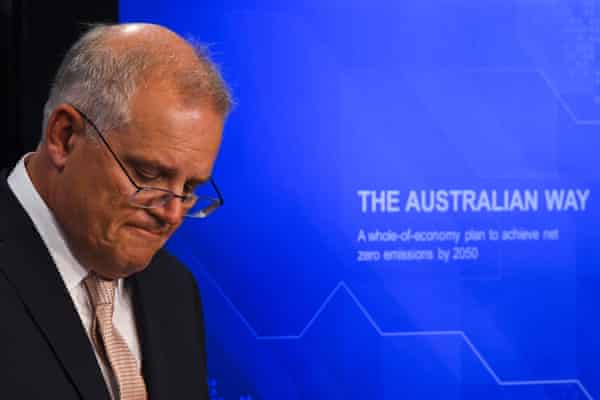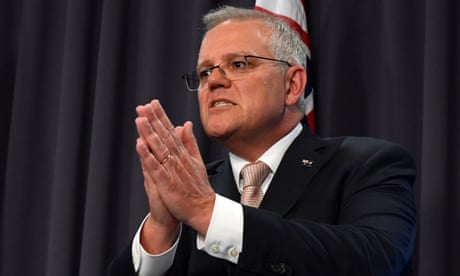Extract from The Guardian
Scott Morrison’s ‘Australian way’ contains no new emissions reduction policies.

Last modified on Wed 27 Oct 2021 16.03 AEDT
The prime minister’s plan for achieving net zero by 2050 has already come under intense scrutiny since it was unveiled on Tuesday. But what does it all mean? Here are the key things you need to know.
1. There are no new policies
Extraordinarily, given it has been in the works for years, Australia has released a long-term emissions reduction plan that contains no new emissions reduction policies. Morrison described the plan as “the Australian way”.
A slideshow rolled out by the emissions reduction minister, Angus Taylor, was explicit: “The plan is based on our existing policies.”
Taylor says they are guided by five principles: the Coalition’s much repeated line that it backs “technology, not taxes” (which ignores that technology is paid for with tax revenue); no one will be forced to act (“choices not mandates”); technologies’ cost will come down; there will be “affordable and reliable power”; the government will “be accountable for progress”.
The government is more or less claiming its current path will be enough
Broken down, it means the government is more or less claiming its current path will be enough. It backs this up by arguing it has runs on the board: emissions are already down 20% since 2005.
But if you remove the impact of Covid-19, national emissions have dipped little more than 3% since the Coalition was elected in 2013. Nearly all the cut since 2005 came when Labor was in power, and it was mostly due to changes in state land-clearing laws and forestry.
There are a couple of minor changes in the plan. “Ultra low-cost solar” has been added to a list of priority technologies, but it is not immediately clear what difference this will make – solar is already cheap, and the report boasts that government agencies have invested more than $4.3bn in solar to help it get to this point.
The government says it wants to set up an international carbon crediting scheme with its partners in “the Quad” – the US, India and Japan – which could be significant if it gets going, though there are few details.
The plan also mentions changes already under way to the safeguard mechanism – a policy that was supposed to limit industrial carbon pollution, but hasn’t – that would offer incentives to companies to make cuts, but Taylor has ruled out requiring companies to reduce emissions.
There is no new funding attached to the plan. Morrison indicated that could change in a pre-election budget, but for now – despite the prime minister’s claims Australia was a global leader in clean tech investment – it spends much less than some comparable countries, such as Germany and South Korea.
2. There is no actual plan. Technology will save us
The big theme is that, against the global trend, nothing will be compulsory. Basically, the government will pay for some technologies and some incentives to emitting industries, and the market – business and consumer choice – will do the rest.
This, of course, means the emissions reduction plan is not a plan in a literal sense. There is no roadmap to net zero.
The
government assumes most of the cuts will happen closer to 2050 than
today, an approach that critics were quick to compare to net zero
announcements by climate laggards Saudi Arabia and Russia. It is the
opposite of what scientists say is necessary.
Scott Morrison stressed the net zero plan not going to ‘shut down coal and gas production’. Photograph: Lukas Coch/AAP
Modelling by energy department staff and consultants at McKinsey apparently suggests “existing priority technologies” will “get us 85% of the way” to net zero, with 40% of the total coming from the government’s technology investment roadmap, which aims to lower the cost of things such as energy storage, carbon capture and storage (CCS) and “clean” hydrogen, steel and aluminium.
It is impossible to assess this – the modelling itself hasn’t been released and Morrison said only it would be out “eventually” – but it seems a remarkable claim. The technology roadmap isn’t designed to cut carbon dioxide by a given amount. Its goal is to reduce the cost of low-emissions technologies over various periods – in some cases a couple of decades – so they can compete commercially.
The report says 15% of the emissions cut to 2050 will come from a vague box described as “global technology trends”, and between 10% and 20% from offsets – which suggests a lot of new trees and storing carbon in soil.
The remaining 15% comes from unspecified “further technology breakthroughs”.
All up, the claim is that technology development will deliver about 70% of the cut required, most of it in 20 years or so, and more than half of that will be the result of Taylor’s tech roadmap policy.
3. It relies heavily on offsets and carbon capture
As mentioned above, the plan assumes offsets will play a major part in reaching net zero. It is not clear to what extent government and businesses, acting voluntarily, will be expected to pay for them.
Offsets are a vexed issue – the “net” in net zero implies we will rely on them to suck carbon dioxide from the atmosphere to cancel out emissions that are too difficult or costly to wipe out entirely. More vegetation and healthier soils are natural solutions.
But as the saying goes, you can’t offset your way to zero. If the worst of the climate crisis is to be avoided, offsets need to be used sparingly, not as an excuse for fossil fuels to run when there are alternatives. Research by ClimateWorks Australia last year found affordable clean options are already available across much of the economy.
Controversially, it also includes CCS – capturing emissions at an industrial site and pumping them underground – as an offset, and suggests it will be needed to make big cuts.
Billions have been committed to CCS with little result to date. If it is to ever work at scale, this technology will be used to limit emissions at particular fossil fuel industrial developments.
It was not intended to be used as a justification for emissions to continue from another site. But the government recently accredited CCS as an offset methodology under its emissions reduction fund.
4. It describes liquified natural gas – a fossil fuel – as ‘clean’
And as “low emissions”. Neither is true (unless it is combined with CCS, which to date happens at only one, troubled Australian site – Chevron’s Gorgon project – where only a fraction of the total emissions are captured and stored underground).

Gas is a fossil fuel with about half the emissions of coal when burned, and more when methane – a particularly potent fossil fuel – leaks during extraction or transport. Photograph: Bloomberg/Getty Images
Gas is a fossil fuel with about half the emissions of coal when burned, and more when methane – a particularly potent greenhouse gas – leaks during extraction or transport.
The net zero report talks about improving LNG’s “long-term competitiveness”, and Morrison stressed at the press conference the net zero plan would not “shut down coal and gas production”.
5. Barely a 1% annual emissions cut is expected to 2030
Along with the net zero plan, the government also put out its annual emissions projections – basically, where existing policies are expected to put the country in 2030.
The projections suggest Australia is now expected to do better than its widely criticised 2030 target of a 26-28% cut compared with 2005 levels. Based on existing policies, they say it should get to at least 30%.
The projections say it could be as much as 35% if the tech investment roadmap is factored. As the climate analyst and author Ketan Joshi explained, in reality the projections report didn’t look at the roadmap at all – it instead took a pre-existing methodology to estimate a high clean tech adoption and said it was now due to the roadmap.

But if we take it on face value, a projected 30%-35% emissions by 2030 puts the official projections roughly in line with (or slightly below) recent independent assessments by ClimateWorks and Climate Analytics. Those analyses attributed the expected deeper cut in emissions largely to state-based action supporting renewable energy and electric vehicles.
The noteworthy point here is that, for all the talk about meeting and beating its targets, the numbers suggest the government expects relatively slow progress in emissions reduction over the next decade.
The projections are a significant improvement on last year – up from a 22% cut – and the data in the report shows why: expected emissions from electricity continue to come down significantly as clean energy replaces coal.
But the new projections range still forecasts emissions will be cut at little more than 1% a year over the next decade.
Several major developed countries have pledged much deeper annual cuts to reach about 50% by 2030 – approaching the global level scientists say is necessary by then. Commitments over the next decade will be the major focus at the Cop26 Glasgow climate talks. The conference president, Alok Sharma, immediately repeated his call that Australia should update its 2030 target next week.
Morrison has already ruled that out. He says he will not increase the country’s target before next year’s federal election.
If he sticks to it he will face world leaders in Scotland and voters in Australia claiming the evidence shows he will do more on climate over the next few years, but that he is not prepared to make that an actual commitment.
It doesn’t make much sense, but this is climate politics the Australian way.
.png)
No comments:
Post a Comment